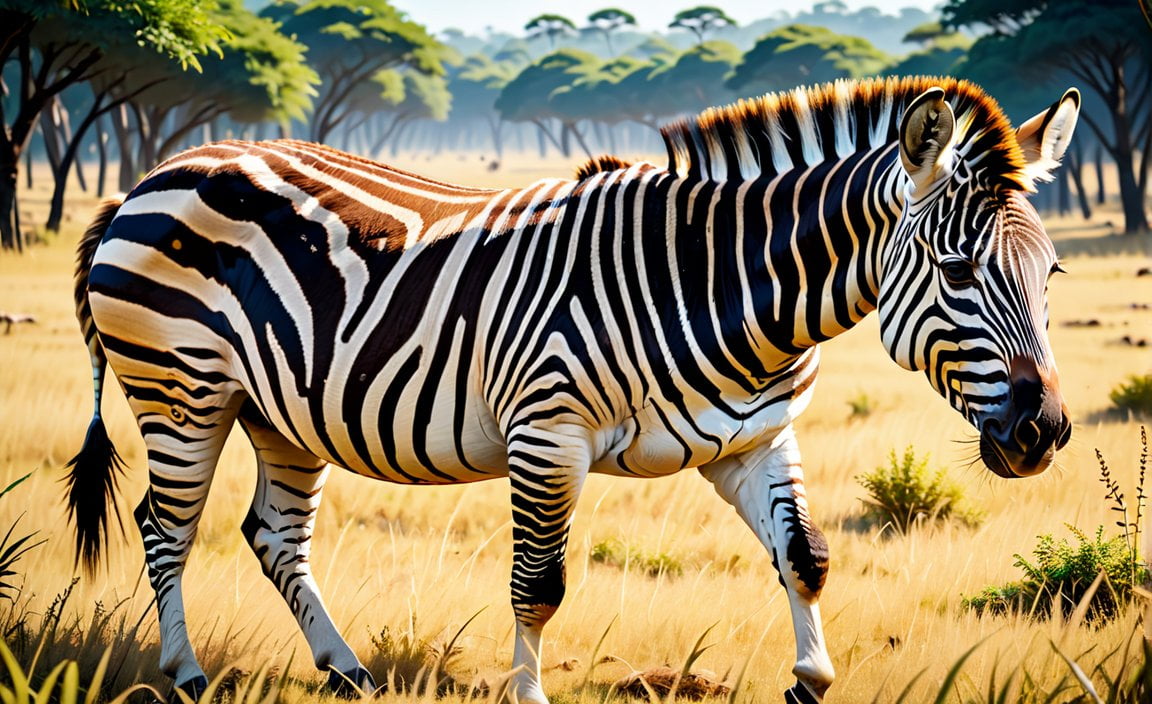Understanding the Dangers: Are Zebras Dangerous?

When we think of dangerous animals, zebras may not be the first species that come to mind. However, these seemingly gentle and docile creatures can, in certain situations, pose risks to both humans and other animals alike. As an expert wildlife journalist specializing in predator and grazer behaviors, I have closely studied zebras and their interactions with their environment for years. Through my extensive research, I aim to shed light on the lesser-known dangers that zebras can present and provide valuable insights into their behaviors and potential threats to human safety.
Key Takeaways:
- Zebras can display aggressive behavior when they feel threatened or provoked.
- They can kick, bite, and push their attackers to defend themselves and their herd.
- Zebras are considerably more aggressive than most other equine species.
- Zebras are not domesticated and remain predominantly wild.
- Attacks on humans by zebras are rare but can be fatal.
Are Zebras Dangerous?
Zebras are often regarded as gentle and docile creatures, characterized by their beautiful black and white striped coats. However, beneath their charming appearance lies a surprising truth – zebras can be dangerous. While they may not pose a significant threat to humans on a daily basis, it is crucial to understand the potential dangers associated with these seemingly harmless animals.
When Zebras Feel Threatened
Zebras are known for their defensive nature and can display aggressive behavior when they feel threatened or provoked. They have a unique way of defending themselves and their herd – kicking, biting, and pushing their attackers. These actions serve as a form of self-defense and show their determination to protect themselves and their companions.
Zebras vs. Other Equine Species
One might wonder: how do zebras compare to other equine species in terms of aggression? It turns out that zebras are considerably more aggressive than their domesticated counterparts, such as horses and donkeys. While horses and donkeys have been tamed and bred for domestication over centuries, zebras remain predominantly wild and have not undergone the same domestication process. This inherent wild nature contributes to their potentially dangerous behavior.
Instances of Zebra Attacks
Fortunately, attacks on humans by zebras are rare. However, it is essential to note that they can happen, and when they do, they can be fatal. Zebras view humans as a potential threat and may react aggressively if they feel their safety or the safety of their herd is compromised. Instances of zebras attacking and killing lions, a predator far more formidable than humans, further emphasize their defensive capabilities.
Zebras and Domestication
Unlike many other animals, zebras are not suitable for domestication due to their unfriendly and potentially dangerous temperament. Domestication typically involves breeding animals to adapt to a human-controlled environment, fostering a harmonious relationship. However, zebras’ aggressive nature makes it challenging to establish such a connection. This lack of domestication contributes to their inherently dangerous tendencies.
In conclusion, although zebras may not appear dangerous at first glance, they possess the potential for aggression that should not be underestimated. When faced with threats or provocation, zebras can exhibit behaviors such as kicking, biting, and pushing to protect themselves and their herd. While attacks on humans are rare, they can still occur and result in severe consequences. Zebras’ primarily wild nature and their unique characteristics make them inherently dangerous animals. It is crucial to approach and interact with zebras with caution, respecting their natural instincts and boundaries.
Check out these fascinating facts about how high elk can jump! You won’t believe the incredible heights they can reach. Learn more about it here.
Discover some dangerous facts about lions that will leave you on the edge of your seat. Click here to find out more.
Curious to know if tortoises can eat mushrooms? Click here to explore this interesting topic.
Explore the world of the Palomino Tennessee walking horse and discover why it’s such a remarkable breed. Learn more about it here.
Unveil the legends and mysteries surrounding the Nyaminyami snake. Click here to dive into the intriguing tales.
Interested in learning more about horses? Click here to access a comprehensive horse fact file packed with interesting information.
Instances of Zebras Exhibiting Dangerous Behavior
Zebras, those strikingly beautiful creatures with their iconic black and white stripes, may seem harmless and docile from afar. However, closer observation reveals a different truth. Zebras can exhibit surprisingly dangerous behavior when they feel threatened or provoked.
The Aggression of Zebras:
One of the distinguishing traits of zebras is their aggression. Compared to other equine species like horses and donkeys, zebras are considerably more aggressive. They have been known to push, kick, and even bite to defend themselves and protect their herd. In fact, instances of zebras killing lions have been reported, especially when the zebras feel threatened or cornered.
Male Zebras: Stallions on the Defense
Male zebras, known as stallions, are particularly formidable and protective. Their aggression stems from their instinct to safeguard their territory and their herd. When predators venture too close, they are quick to launch an attack, using their powerful kicks and bites to fend them off.
Female Zebras: Mothers Unleashing Fury
Female zebras, or mares, are known to become extremely aggressive when their offspring are threatened. Just like any loving and protective mother, they will stop at nothing to ensure the safety of their young ones. Zebras may seem gentle and quiet, but when it comes to defending their offspring, they can unleash their fury in a intimidating display of aggression.
The Natural Instincts of Zebras:
Zebras are herbivores, primarily feeding on grass. However, during scarcity or harsh environmental conditions, they may resort to consuming leaves, shrubs, twigs, and bark. It is important to understand that their natural foraging instincts can sometimes lead them to compete for limited resources, which may provoke aggressive interactions between zebras and other animals.
Zebras and Human Interaction:
While zebras are fascinating creatures, they are not suitable for domestication. Their unfriendly and potentially dangerous temperament makes it clear that they are not people-friendly. It is essential to acknowledge that riding a zebra is not only unsafe for the rider but also cruel to the animal, as their sharp hooves can cause serious harm.
Key Takeaways:
- Zebras can exhibit dangerous behavior when they feel threatened or provoked.
- Male zebras, or stallions, are particularly aggressive and will attack predators that get too close.
- Female zebras, or mares, become extremely aggressive when their offspring are in danger.
- Zebras are herbivores, but environmental scarcity can lead to aggressive interactions with other animals.
- Zebras are not suitable for domestication and are not people-friendly.
- Riding a zebra poses risks to both the rider and the zebra due to their sharp hooves.
Sources:
– Animal Answer Guide – Are Zebras Dangerous & Aggressive?
– Equine Desire – Are Zebras Dangerous?
Potential Threats Posed by Zebras to Humans and Their Habitats
Zebras, with their striking black and white stripes, are often seen as gentle and docile creatures. However, it is important to understand that they do have the potential to pose certain threats to humans and their habitats. In this article, we will explore the potential dangers associated with zebras and shed light on their behavior and interactions with humans and their environment.
Are Zebras Dangerous?
While zebras are not inherently dangerous, they can display aggressive behavior when they feel threatened or cornered. Startling or provoking a zebra may result in them kicking or biting in self-defense. It is crucial to approach and interact with zebras with caution, respecting their natural instincts and boundaries. This is particularly important in areas where humans and zebras coexist, such as national parks and wildlife reserves.
Understanding Zebra Behavior
Zebras have different social patterns depending on their species, and their behavior can be influenced by various factors such as food availability, parasites, predators, and environmental pressures. These factors can affect their behavior, social relationships, and even their potential threats to both humans and their habitats.
Conservation Concerns
Conservation efforts are essential, as some zebra species are facing significant challenges. The Grévy’s zebra, for example, is the most endangered species, with fewer than 2,000 individuals remaining. Mountain zebras are vulnerable, with fewer than 35,000 individuals, and plains zebras are also at risk, with a declining population of 150,000 to 250,000. Maintaining their habitats and addressing human-wildlife conflicts are crucial for their long-term survival.
Evolutionary Adaptations
Zebras have evolved certain adaptations that help them survive in their habitats. Their endurance and resistance to domestication may be attributed to their long history of coexistence with predators, including humans. Understanding these adaptations can provide insights into their potential behavior and the need for caution when interacting with them.
Key Takeaways:
- Zebras may display aggressive behavior when they feel threatened or provoked.
- Conservation efforts are crucial to protect vulnerable zebra species.
- Zebras have evolved adaptations to survive in their habitats.
- Proper caution and respect for their natural instincts are essential when interacting with zebras.
Sources:
– Are Zebras Dangerous?
– 10 Fascinating Facts About Zebras
Tips for Safely Interacting with Zebras in the Wild
Are zebras dangerous? While they may appear harmless, it is important to maintain a safe distance from wild zebras and understand their behaviors when encountering them in their natural habitat. Here are some tips for safely interacting with zebras:
- Maintain a safe distance: Zebras are wild animals and should be observed from a distance. It is crucial to give them plenty of space, especially when they are in a large herd. Approaching them too closely can cause distress and increase the risk of an attack.
- Use binoculars: Rather than approaching zebras closely, use binoculars to observe them from a safe distance. This allows you to appreciate their beauty and behavior without risking your safety.
- Avoid touching or feeding zebras: Refrain from attempting to pet or feed zebras. Touching or feeding them can provoke defensive or aggressive behavior. Remember, zebras are not fully tamed or domesticated and should be treated with caution and respect for their wild nature.
- Educate yourself: Learn about zebra behavior and instincts to better understand how to interact with them safely. By understanding their social patterns and instincts, you can avoid actions that may be perceived as threatening or provoke aggressive behavior.
Remember, zebras are not generally friendly to humans. Although some pictures or videos may depict people or animal trainers being friendly with zebras, it is important to recognize that these animals are not fully tamed or domesticated. Approach them with caution and respect for their wild nature.
In conclusion, by maintaining a safe distance, refraining from touching or feeding zebras, using binoculars for observation, and educating yourself about their behavior, you can ensure a safer and more enjoyable experience when encountering zebras in the wild.
Source: Only4Life – Zebra Behavior
Key Takeaways:
- Maintain a safe distance from zebras, especially in large herds, to avoid distress or potential attacks.
- Use binoculars to observe zebras from a safe distance instead of approaching them closely.
- Refrain from touching or feeding zebras to prevent defensive or aggressive behavior.
- Educate yourself about zebra behavior and instincts to interact with them safely.

FAQ
Q1: Are zebras inherently dangerous animals?
A1: While zebras are not inherently dangerous, they can display aggressive behavior when they feel threatened or provoked. It’s important to understand their behaviors and instincts to ensure safety when encountering zebras in the wild.
Q2: Can zebras attack humans?
A2: While zebras rarely attack humans, there have been instances where they have acted aggressively when provoked. It’s crucial to maintain a safe distance and avoid any actions that may provoke defensive or aggressive behavior from zebras.
Q3: Are zebras more aggressive than other equine species?
A3: Yes, zebras are considered to be more aggressive than most other equine species. When zebras feel threatened or need to protect their herd, they can kick, bite, and push their attackers to defend themselves and their group.
Q4: Can zebras be domesticated?
A4: Zebras cannot be fully domesticated or tamed. They are wild animals with unpredictable behaviors and instincts. Interacting with zebras requires proper care and safety measures to avoid harm or injury.
Q5: What precautions should be taken when encountering zebras?
A5: When encountering zebras in the wild, it is important to maintain a safe distance, refrain from petting or feeding them, and educate oneself about their behavior and instincts. Giving zebras space and respecting their boundaries can help ensure a safe interaction.
- Unveiling Bernhard Caesar Einstein’s Scientific Achievements: A Legacy in Engineering - July 15, 2025
- Uncover who is Jerry McSorley: CEO, Family Man, Business Success Story - July 15, 2025
- Discover Bernhard Caesar Einstein’s Scientific Contributions: Unveiling a Legacy Beyond Einstein - July 15, 2025















